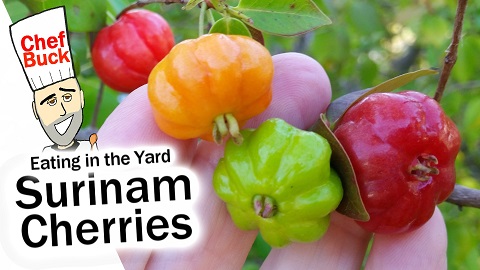Do you have a Surinam cherry tree in your yard? Surinam cherry hedges and shrub trees are often planted as ornamentals, but the fruit is edible and quite tasty when ripe.
When is a Surinam Cherry Ripe?
In some areas, the Surinam cherry is a nuisance plant, but the tiny pumpkin shaped cherries are tangy and tasty when eaten at the right moment. You can find cherries on the tree ranging from pale green to rich orange to ruby red, all at the same time. Surinam cherries are ripest and most tasty when VERY red. Do not eat cherries that are green, and you’ll probably want to avoid orange and less red cherries as well, since they can be quite tart.
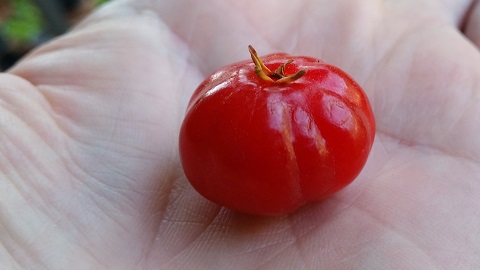
To enjoy ripe Surinam cherries, pick them only if they are a deep red or even darker. And do not tug the fruit off of the tree. The cherries pull away easily when ripe. The taste of ripe surinam cherry is tangy, sweet, and refreshing.
A Surinam cherry looks like a miniature pumpkin the size of a regular cherry. The skin and fruit are edible, but in the center is a roundish pit you do not eat. You can plant the pit and grow another Surinam tree. The trees bear fruit in the spring and fall seasons.
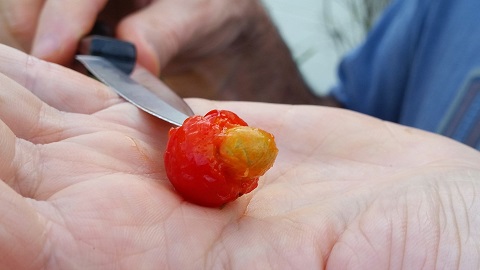
Use Surinam cherries the same as your favorite berries, in pies, jams, jellies, sauces, syrups, and ice cream, or just pluck them from the tree and enjoy. The fruit contains healthy antioxidants, and is a good source of vitamins C and A.
Where Do You Find Surinam Cherries?
Surinam cherry plants grow readily, are hardy, and require little care. Mature trees can reach to over 20’ tall. They are grown into hedges and used as a decoration or as a natural privacy border. The plants grow so easily, that in some areas they are classified as a nuisance plant. Plants popped up in Florida around the 1930’s and over the decades became a popular yard feature, but by the 1980’s they lost favor, seen as out-of-control, and viewed as an invasive species. Many plants were eradicated in Florida, but many survive. I’m glad there’s one in my Mother-in-Law’s yard, because it’s a nice treat to plop in my mouth when I stroll out to the back porch.
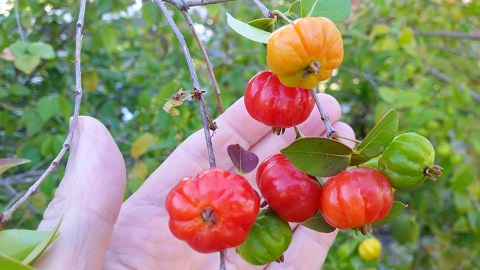
The Surinam cherry tree is native to South America and named after the country of Suriname. They are also called a Brazilian, Cayenne, or Florida cherry, depending on where you ask. You can find the cherries in the Caribbean islands, as well as Florida, Bermuda, and many tropical areas around the globe. If you live in a tropical climate, maybe there’s a tree near you. Surinam cherries are not often available commercially, so being in an area where the trees grow naturally might be your best chance of sampling this fruit.
It’s a hardy plant that loves a tropical climate, so if you live in a place that doesn’t get too cold, you might plant your own tree in a pot or a patch in the yard. You can look at current prices for Surinam Cherry Plants on Amazon.
Look here if you want more sciencey info about Surinam cherry trees.
Another fruit we enjoy eating during our travels is fresh tropical papaya.
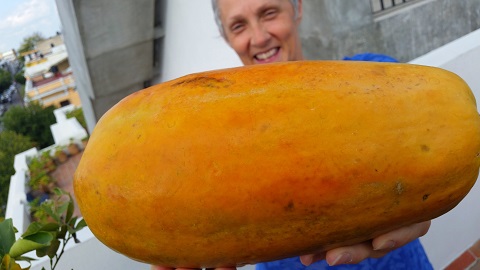
Thanks for checking out our Surinam cherry video, and all of our recipe and food blogs. Sign up for our mailing list to never miss a new Chef Buck cooking video, and click a button below and share the dishes with your friends. We appreciate all the kind comments and support, and we’ll see you next time in the kitchen!
–Chef Buck
Thanks watching our food videos!
We include affiliate links for products on our website, so if you make a purchase after clicking on our links, we might earn a commission which helps us produce more videos and drink more coffee :^) We participate in the Amazon Services LLC Associates Program, which is an affiliate advertising program that provides a means for us to earn fees by linking to Amazon.com and affiliated sites, so we can make more videos.
